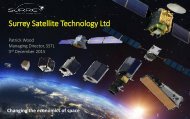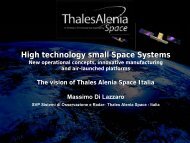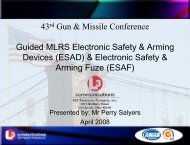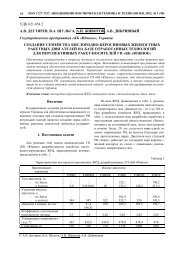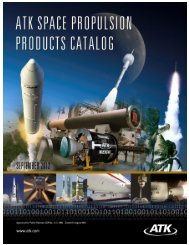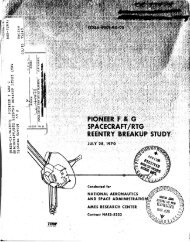5.10.30-TASI-The-Vision-of-Thales-Alenia-Space
5.10.30-TASI-The-Vision-of-Thales-Alenia-Space
5.10.30-TASI-The-Vision-of-Thales-Alenia-Space
Create successful ePaper yourself
Turn your PDF publications into a flip-book with our unique Google optimized e-Paper software.
High technology small <strong>Space</strong> SystemsNew operational concepts, innovative manufacturingand air-launched platforms<strong>The</strong> vision <strong>of</strong> <strong>Thales</strong> <strong>Alenia</strong> <strong>Space</strong> ItaliaMassimo Di LazzaroSVP Sistemi di Osservazione e Radar- <strong>Thales</strong> <strong>Alenia</strong> <strong>Space</strong> - Italia
Introduction• TAS is a World leader in the development <strong>of</strong> high performance Satellite Systemsfor Observation, Telecoms, Navigation .• Capabilities ranges from complex space systems engineering, integration andtesting, to high technology equipments development.• TAS is a system leader in Constellation conception, development, andimplementation.Mastering satellite series production : from COSMO-SkyMed, Sicral, Globalstar,Globalstar 2° generation, Galileo,… to new Iridium-next and O3b.About 150 satellites.High volume production capability means mastering <strong>of</strong> processes, from design toquality control <strong>of</strong> production and subcontractors, processes…Small Satellites and Operationally Responsive <strong>Space</strong> will requireInnovative System Architecture, technology developments andindustrial co-operation to miniaturise high performance systems .2All rights reserved © 2007, <strong>Thales</strong> <strong>Alenia</strong> <strong>Space</strong>
A Complete Range <strong>of</strong> <strong>Space</strong> Competence and Technologiesready for microsatellitesSATELLITESPLATFORMSSystem EngineeringMission ConceptionAnalyses and Design,ArchitectureDevelopment, AIV, IOTEnd to-End DeploymentE2E SYSTEMSINSTRUMENTSTECHNOLOGIESEQUIPMENTSPACE SEGMENTPAYLOADSGS EngineeringGS Procurement andQualificationPDS/UGS DevelopmentGROUND SEGMENTSEUROPEAN LEADEREUROPEAN LEADERFROM END-TO-END (E2E) SYSTEMS TO TECHNOLOGY FOR:EARTH OBSERVATION , TELECOMUNICATION and NAVIGATION3All rights reserved © 2007, <strong>Thales</strong> <strong>Alenia</strong> <strong>Space</strong>
System ArchitectureEarth Observation – COSMO-SkyMed4All rights reserved © 2007, <strong>Thales</strong> <strong>Alenia</strong> <strong>Space</strong>
Geographical DistributionKirunaCreilGGSCGSExternalFucinoStationCordobaPraticaF-DUGS di MareMateraFiducial NetworkExternalStationC-UGSD-UGS5All rights reserved © 2007, <strong>Thales</strong> <strong>Alenia</strong> <strong>Space</strong>
Enabling TechnologiesEarth Observation – COSMO-SkyMedActive SAR antenna is a key enabling technologyRADIATINGBOARDTPSUSBCTDLT/R MODULEMajor evolutions being implemented after COSMO :Highly integrated TRM with reduced MMIC, LTCC substratesand Molybdenum Carriers, Po > 42dBm, RF Core Chip forphase and amplitude control, evolution <strong>of</strong> ASIC’s to 18μtechnology…6All rights reserved © 2007, <strong>Thales</strong> <strong>Alenia</strong> <strong>Space</strong>
System ArchitectureTelecommunication - SICRALSicral 1Sicral 1BStazione TT&CEHF SICRAL 1Stazione TT&CEHF HardenStazione TT&Cbanda SStazioneTT&C EHFFE “EHF”FE “EHF”FE “S”TLC UHFTLC SHFFE “EHF”Satellite ControlCenter (Fucino)Satellite ControlCenter (Vigna diValle)TLC Control Center(Vigna di Valle)7All rights reserved © 2007, <strong>Thales</strong> <strong>Alenia</strong> <strong>Space</strong>
Enabling TechnologiesTelecommunication - SICRALUHF AntennaAntenna moduleSolar ArrayDeploymentDefense telecom system to for tactic and strategic useMulti-transmission communication payload operating in several frequency bands:• EHF Band (20-44 GHz), mainly devoted to infrastructural communication, with anantenna which footprint principally covers the Italian territory• UHF Band (260-300 MHz), primarily used for tactical mobile communication, withantenna footprint that covers the hemisphere <strong>of</strong> the Earth visible by the satellite• SHF Band (7/8 GHz), complementary to the EHF band, devoted to the largebandwidth communications8All rights reserved © 2007, <strong>Thales</strong> <strong>Alenia</strong> <strong>Space</strong>
Current product capabilitiesSmall Satellites Telecom ConstellationsGLOBALSTAR-2, O3B, and the IRIDIUM-NEXT.Globalstar-2’s networkwill consist <strong>of</strong> 48 satellitesfor worldwide personalphone communication, whichwill replace the existingGlobalstar-1 system alreadydeveloped by TAS.9O3B's networkwill consist <strong>of</strong> 16 satellitesfor faster, affordable internetto all the world's uncoveredregions. Same platform <strong>of</strong>Globalstar-2.Iridium-next's networkwill consist <strong>of</strong> 66 satellitesproviding voice and datacoverage to satellite phonesand integrated transceiversover Earth's entire surfaceAll rights reserved © 2007, <strong>Thales</strong> <strong>Alenia</strong> <strong>Space</strong>
Available PRIMA-S PlatformTechnology Ready for mini-SatelliteCurrent products allow theimplementation <strong>of</strong> minisatellite configurationsCompact SARMini-SatelliteOpticalMini-Satellite<strong>Space</strong>craft parametersPossible Payloads<strong>Space</strong>craft structureLaunch massAOCS (Attitude &Orbit ControlSubsystem)Aluminum structure, Size: 1.3x1.3x1.3 m400-500 kg- Gyro, Sun Sensors, Star Trackers,Magnetometer- Autonomous GPS position determination- 3-axis attitude control, 4 RW- 1 hydrazine tank, up to 130 kg capacity; 4thrusters 1 N configurationSIGINTELINTTLCInterception and decryption <strong>of</strong> military andstrategic communicationsTELINT: Receptions <strong>of</strong> telemetry signalsduring ballistic missile testsInterception <strong>of</strong> radar signalFor tactical useEPS (Electric PowerSubsystem)-Power generated by two deployable solararray (GaAs; up to 1500 W EOL)- 1 Li-ion battery; PCDU (Power & ControlDistribution Unit)SARCompact SAR reflectorOn-board datahandling- On-board computer- 2 S-band transceivers for communicationOpticalPanchromatic, Hyperspectral,IRPayload datamanagement- X band downlink- Storage memoryPerformance - Payload mass: up to 200 kg- <strong>Space</strong>craft high agilitySounder,MeteorologySubsurface and atmosphere sounding10All rights reserved © 2007, <strong>Thales</strong> <strong>Alenia</strong> <strong>Space</strong>
TAS I understanding <strong>of</strong> ORS Key Requirements• <strong>The</strong> average time for deploying a <strong>Space</strong> Asset using existing technologiesis today in the order <strong>of</strong> 24 months.• That’s too long for applications that cannot be planned such as militarytactical operations.• New <strong>Space</strong> Systems requirements which may be met by small satellites:• Responsiveness -trough:provide required information when they are needed Single Function - 1 payload per spacecraft Fast integration & Verification (hours) => modular architecture, standard,plug and play Rapid launching system (days) => aircraft launch Secure overall infrastructure to deliver acquired data Data delivered to the end user nearly immediately in a form that they canuse11All rights reserved © 2007, <strong>Thales</strong> <strong>Alenia</strong> <strong>Space</strong>
TAS I understanding <strong>of</strong> ORS Key Requirements(cont’d)• New <strong>Space</strong> Systems requirements which may be met by small satellites:• Flexibility - Provide multiple types <strong>of</strong> data (from different satellitesbased on the same bus)• Short duration - 6 months mission, optionally improved by propulsionsystem to 1-2 years• Micro S/L Class - 100Kg/300W ... Can be launched by available lowcost rapid systems in response to worlds events or immediate needs: Reconstitute lost capabilities - Augment/Surge existing capabilities Fill Unanticipated Gaps in capabilities - Focused coverage that can’t bepredicted• Low Altitude - 200-400Km (allows small payloads & betterperformance)12All rights reserved © 2007, <strong>Thales</strong> <strong>Alenia</strong> <strong>Space</strong>
Small <strong>Space</strong> Systemsto enhance the defence space assetsSmall <strong>Space</strong> Systems integrated and interoperable withcurrent <strong>Space</strong> Assets <strong>of</strong> Defense (COSMO, SICRAL), toenhance their capabilities:•Improve responsiveness and effectiveness for specific crisisscenario•Additional sensors (optical, passive, sounders…) and telecomservices•Complement COSMO observations, using same ground networkand having data fusion in processing•LEO Telecom services may use SICRAL 1B as GEO (visible atleast for 10min in most orbits)•A real breakthrough may result from deployment <strong>of</strong> low costformations, for Imaging, ELINT, Telecom and other operationalapplications (e.g. meteorology)13All rights reserved © 2007, <strong>Thales</strong> <strong>Alenia</strong> <strong>Space</strong>
Possible Launch ScenariosSeveral launch Options are possible for the proposed Micro-Satellites <strong>of</strong> which thetwo dominant low cost are:• Expendable Launch Vehicle (ELV) Delta 4, Atlas v, Delta 2, Zenit 2 , Soyuz, Taurus PSLV, Falcon.• Converted Missiles Minotaur 1, Cosmos 3M, Dnepr 1, Start, Rockot, Minotaur 4.In addiction Micro Satellites meet Avio Launch requirements: E.g. Pegasus, QuickReach14All rights reserved © 2007, <strong>Thales</strong> <strong>Alenia</strong> <strong>Space</strong>
Micro-Class Multi-Purpose Satellite ConceptMicro-Satellite 100 kg – 300 W• Platform : Multi-purpose Fast integration & verification Fast commissioning & calibration• Responsive launch (on Demand).SARSIGINTOptical<strong>Space</strong>craft structure<strong>Space</strong>craft lauch massAOCS (Attitude & OrbitControl Subsystem)EPS (Electric PowerSubsystem)Micro-S/C spacecraft parametersHoneycomb, Size: 0.8 x 0.8 x 0.8 m< 100 kg- Sun Sensors, Star Trackers,(Magnetometer), (Gyro)- Autonomous GPS position determination- 3-axis attitude control, 4 Micro-CMG- Chemical propulsion 2-4 thrusters-Power generated by two deployable solararray (GaAs; up to 300W)- 1 Li-ion battery; Power & ControlDistribution ModuleOn-board data handling - On-board computer integrating data handlingmanagement and transceiver communicationPerformance- Payload mass: up to 45% <strong>of</strong> launch mass- <strong>Space</strong>craft high agilityELINT,SIGINTTLCSAROpticalSounder,MeteorologySHF- UHFCommsStoreForwardPossible InstrumentsSmall instruments, flying formationsFor tactical use, single or formationsSmall instruments, flying formationsPanchromatic, Hyperspectral,IRSubsurface and atmosphere sounding-Secure Comms. Data communication at2Mb/s with S1B ad DRS (secure, global,integrated)-S1B UHF also could be used for H/K withlarger coverage with data rate <strong>of</strong> 2Kb/s.-Enlarge the Sicral1B Operative Area by Storeand Forward service.15All rights reserved © 2007, <strong>Thales</strong> <strong>Alenia</strong> <strong>Space</strong>
Micro-Class Multi-Purpose Satellite ConceptStandard PlatformBUSPAYLOADHelicoidal ELINTAntennaSolar ArrayStar TrackerStandard Platform with integrated high performanceCommunications and Data Handling:• Flexibility <strong>of</strong> Inter-Satellite Link (ISL) in for flyingformations and DRS to GEO• TT&C, Payload Downlink and ISL are integrated toreduce mass and power, allowing to managemultiple data flow .OpticalTelescopeX-bandMini SAR16All rights reserved © 2007, <strong>Thales</strong> <strong>Alenia</strong> <strong>Space</strong>
EO Mission – SAR Satellites Constellation17LEO Sun Synchronous Orbit grants globalEarth access capabilities (including polarregions).LEO inclined allow to improve the revisit timeperformance on the mid latitude andequatorial areas but do not allow globalEarth accessSAR Payload grants night/daylight and allweather observation capabilities.Access areas can be both right and leftlooking within a typical incidence angle rangefrom 20° to 60°<strong>The</strong> revisit time depends on the selectedorbital design and on the number <strong>of</strong>deployed satellitesOn the whole Mediterranean areas aconstellation <strong>of</strong> 12 SAR satellites operatingat about 300km altitude is able to provide anaverage revisit time ranging from 2 hours(inclined solution) to 3 hours (SSO solution).LEO InclinedLEO SSOAll rights reserved © 2007, <strong>Thales</strong> <strong>Alenia</strong> <strong>Space</strong>
EO Mission – Optical Satellites ConstellationLEO InclinedLEO SSOOptical Payload requires daylight and cloudfree observation conditions.Access area is nadir looking with a typicalFOV <strong>of</strong> +/-50°<strong>The</strong> revisit time depends on the selectedorbital design and on the number <strong>of</strong>deployed satellites.On the whole Mediterranean areas aconstellation <strong>of</strong> 12 Optical satellitesoperating at about 300km altitude is able toprovide an average revisit time ranging from3.5 hours (inclined solution) to 4.5 hours(SSO solution).Solar illumination condition (e.g. reduced inWinter season on the northern hemisphere)and cloud coverage distribution can degradethese performance.18All rights reserved © 2007, <strong>Thales</strong> <strong>Alenia</strong> <strong>Space</strong>
Envisioned Operational ScenariosSICRAL 1BEDRSGB2 / IridiumLASERUHFSHFGB2 / IridiumOpticalSARElintFormationTargetTargetTarget19CONTROLCENTERAll rights reserved © 2007, <strong>Thales</strong> <strong>Alenia</strong> <strong>Space</strong>
Single Satellite Responsive OperationSingle Satellite Responsive Operation34PRE-TASKINGTarget Area1. Send Tasking2. Uplink Tasking253. Target Acquisition4. Downlink Tactical Product5. Data Transmission to theWarfighterMobile GroundStation1WarfighterGround Network20All rights reserved © 2007, <strong>Thales</strong> <strong>Alenia</strong> <strong>Space</strong>
Enhanced Applications: Formation FlyingFormation Flying can enhance Mission Performance over single satellite :• Access to targets from multiple angles or for longer time• Opportunity to create synthetic apertures for interferometry or radar surveillancemissions and to increase the scope <strong>of</strong> field measurements for survey missions.• Flexibility and Responsiveness• Robustness and failure tolerance (at constellation level)• Cost effective space systemsKey technologies :• Intra Satellite Link (ISL) & synchronization among spacecrafts• Accurate control <strong>of</strong> orbital position and relative baselineMission Domains:• Optical• Multi-static (MIMO) SAR formationsSuper-resolution imagery in range and azimuthDigital elevation ModelMoving Target Detection• Passive ObservationELINT : extended coverage, Direction Finding Techniques (DOA)Microwave Radiometry (coverage, resolution with passive interferometry)21All rights reserved © 2007, <strong>Thales</strong> <strong>Alenia</strong> <strong>Space</strong>
SAR Micro-SatelliteMain features• Programmable access by satellite elevationsteering in the range [20° .. 30°] (i.e. 60 kmaccess region @300km altitude)• Strip-map mode• Programmable range resolution (1..3 m)ParameterValueAccess Region 20° …. 30°Swath 8 … 10 kmParameterFrequency BandPRF9600 MHz10 .. 15 kHzValueResolutionAzimuthRange0.7 mSubmetric as a targetPulse WidthPulse Bandwidth20 us135 .. 400 MHzTx Duty Cycle 20 .. 25%Nes°(@ 1m Rres)(@ 3m Rres)-15 dB-20 dBPeak RF PowerPeak DC Power(short time)2000 W1500 W22All rights reserved © 2007, <strong>Thales</strong> <strong>Alenia</strong> <strong>Space</strong>
Micro Satellite SHF TX/RX Data RelayMicro Satellite SHF TX/RX features:• Micro-strip Patch Array Antenna 12elements• X-Band sat-com STANAG 4484 : 7.25-7.55 GHz uplink 7.90-8.40 GHz downlink Tx Power ~10 WLink and data handling performance:• Data Rate: 2Mbps(1Mbps) with 0.5mpointing (fixed) antenna• TX/RX Carrier shift for DopplerCompensation On Board• Optional data storage up to 1000 Gbits,with Flash memories or hard disks.• Optional high rate X-Band downlink (>200Mbps) using high order adaptivecoding and high gain antennas.Synchronization services for MicroSatellites flying formations:• Interferometry Techniques for ELINT• Interferometry Techniques for SAR23All rights reserved © 2007, <strong>Thales</strong> <strong>Alenia</strong> <strong>Space</strong>
Optical Micro-Satellite.• S/C mass: 100 kg option (about 30 kg payload mass)GSD : metric order (at nadir) @ 300 kmoptical aperture less than 40 mmswath width: 40 kmCommunications: TT&C S-Band and Image transmission X-Band• S/C mass: 150 kg options (about 45 kg payload mass)GSD : 1 meter order (at nadir) @ 300 kmoptical aperture less than 200 mmswath width: 15 kmSpectral bands: PAN+RGB+NIRCommunications: TT&C S-Band and Image transmission X-Band• FeaturesLow cost, maintain high performances and data quality;Design to produce high data volume per day;Design for low-cost constellation able to enhance system response capability and deliveringfrequent and reliable information;Platform design to provide the necessary highly agile attitude control, the system is capable<strong>of</strong> time delay integration and rapid pitch and roll <strong>of</strong>f-pointing, with the necessary stability.24All rights reserved © 2007, <strong>Thales</strong> <strong>Alenia</strong> <strong>Space</strong>
ELINT & SIGINT Micro-SatelliteGuard elementSatellite clusters for ELINT• Single satellite operations• Cluster (cooperative) operations, tobetter performance in terms <strong>of</strong>: Detection Emitters localizationResulting lobepatternsSingle antenna apertureComposite antennaAntenna clusterFrequencies <strong>of</strong> interest:Pure ELINT• Navigation radars (2.9 - 3.1 GHz and 9.2 -9.5 GHz in the S and X bands)• Surveillance radars (1 - 8 GHz in the L, Sand C bands)• Tracking and fire control radars (8 - 20 GHzin the X, Ku and K (partly) bands)Other applications• In addition to radar emitters, radar jammersand GPS jammers (at ~1.2 and ~1.5 GHz).25All rights reserved © 2007, <strong>Thales</strong> <strong>Alenia</strong> <strong>Space</strong>
Small <strong>Space</strong> Systems : <strong>Vision</strong><strong>The</strong> vision is in the Title <strong>of</strong> our Meeting: High technology small <strong>Space</strong> SystemSubsystem and equipments modularity and scalability:• Inject new technology for miniaturization• Standardisation and re-use <strong>of</strong> “building blocks”• Seamless adaptability/configurability• Rapid final testability/deploymentSystems modularity and scalability (e.g. “Formation Flying”, “Fractionatedspacecraft systems”):• Distributed architectures• Multifunctional systems (e.g. in flight re-configurability)• Inter-satellite and space-ground links• High level <strong>of</strong> automation and autonomyStrong interoperability with current <strong>Space</strong> assets• Enhance performance and capability <strong>of</strong> existing systems (e.g. COSMO, SICRAL,….)• Re-use <strong>of</strong> existing infrastructures for cost effective missions (e.g. Ground segment,operational procedures, processors, data fusion, etc.)26All rights reserved © 2007, <strong>Thales</strong> <strong>Alenia</strong> <strong>Space</strong>
Final notes• Italy has done the right investments that have created the necessaryheritage, know-how and facilities to undertake the challenge to lead anItalian development for a Micro-Satellite based mission• Enabling Technologies for MicroSats have been identified, as well aspotential applications• OSR and Microsatellite is not a Single company effort• Led by MoD and Agencies, TAS I, teaming with PMI and otherenterprises, proposes to define suitable mission pr<strong>of</strong>iles and industrialplans in order to :• Execute feasibility and definition studies• Establish development plans• Plan the key technology developments Modular expandable micro-bus Plug and Play Payloads (Radar, ELINT, SIGINT, Optical)• Propose & Develop a demonstrator27All rights reserved © 2007, <strong>Thales</strong> <strong>Alenia</strong> <strong>Space</strong>



